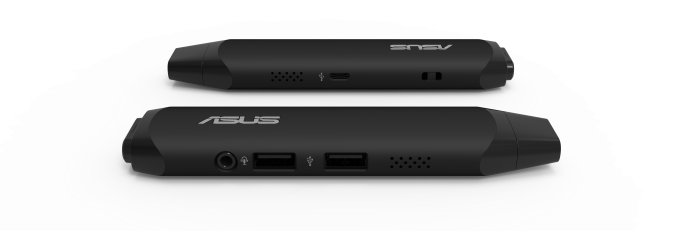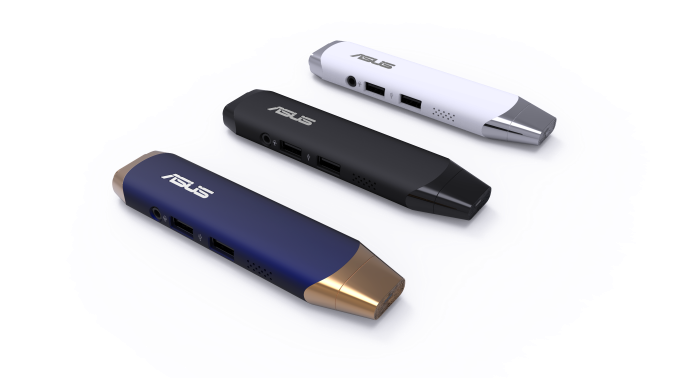Asus Announces the VivoStick PC - A Cherry Trail Compute Stick
by Ganesh T S on September 2, 2015 7:00 AM EST- Posted in
- Asus
- Systems
- Intel
- Cherry Trail
- HDMI Stick

At IFA 2015, Asus is announcing their first PC in the 'compute stick' form factor, the VivoStick PC. As a recap, the Compute Stick form factor is the x86 version of the popular ARM-based HDMI sticks. The first generation x86 Compute Stick came from Intel and used a Bay Trail-T SoC. Despite looking like an oversized thumb drive, the unit was actively cooled.
Asus's first foray into this form factor comes with the 14nm Cherry Trail platform. Unlike Intel's Compute Stick, the Asus VivoStick appears to have a good industrial design. The main differences between the Bay Trail-T Compute Stick that we have already reviewed and the VivoStick PC being announced today are:
- Removal of microSD slot
- Windows 10 Home instead of Windows 8.1 with Bing
- eMCP (multi-chip package) integrating 2 GB of DDR3L and 32 GB of flash memory in a single package, thereby reducing the board area
- 1x USB 3.0 port
The other aspects include availability of a 802.11 b/g/n and BT 4.0 chip for communications. The 138mm x 15mm x 14mm package weighs 70g. The VivoStick also comes in multiple colours. Asus is yet to decide whether to actively cool the device or not.
Asus did not announce any availability dates, but did indicate that the units are expected to have a MSRP of $129. As I have mentioned in multiple reviews, 32GB of primary storage is hardly enough after a couple of major updates. Due to this, the Compute Stick form factor is difficult to recommend as a general PC. However, its sleek and unobtrusive nature as well as low power requirements make it ideal for single purpose computers such as those used in kiosks and other such embedded / industrial applications.











30 Comments
View All Comments
neonspark - Thursday, November 5, 2015 - link
no modern program demands C:\drive installation.TylerGrunter - Wednesday, September 2, 2015 - link
Exactly this kind of stick but with Android TV is what I would like to see!!!The Android ones tend to be underpowered in every sense. But this has the right combination of RAM/storage/CPU/GPU... and they screw it by using Windows 10.
neonspark - Thursday, November 5, 2015 - link
just install linux if you care so much about not having windows. android tv is a flop anyway.watzupken - Wednesday, September 2, 2015 - link
This is quite silly to be honest. The Windows OS pretty much takes up a chunk of that 32GB, and users do not have any option to expand the storage without the card reader and with a paltry 1 USB port. For 129 bucks, I think the money is better spent on buying a more capable and flexible NUC even though it costs morevectorm12 - Monday, September 7, 2015 - link
actually on the Intel Compute Stick I'm currently upgrading from 8.1 to 10 has 18GB of free space (3GB reported as used by the bone stock OS). Funny thing is the total amount of free space on the stock partition is only 21,9GB which means the VIM and recovery partitions use up somewhere in the area of 11GB in total. Not too shabby considering it's a full blown Windows installation. I'm curious to see what the stats will be like once I've finished upgrading it to Windows 10neonspark - Thursday, November 5, 2015 - link
ok, you realize this is not a desktop or tablet PC right? It is basically aimed at apps and streaming, hence storage being secondary since the idea is that your terrabytes of MKVs will be streamed over wifi from your main PC. Thus storage is irrelevant.nmm - Wednesday, September 2, 2015 - link
"As I have mentioned in multiple reviews, 32GB of primary storage is hardly enough after a couple of major updates."Is this in reference to reviews of Windows 10 systems, though? My understanding is that Windows 10 is substantially more compact than Windows 8.1 due to use of compression in system files and the elimination of the recovery partition. It appears a full Windows 10 install should be about 8GB total.
Still I agree from the perspective that 32GB is going to be cramped no matter what — even if Windows 10 were 0 bytes I'd have trouble getting along with only 32 GB of free space on a Windows PC.
mr_tawan - Wednesday, September 2, 2015 - link
AFAIK Windows update does not delete the update files after it's succussfully applied to the system. So while the user can delete it themselves, it's pretty annoying to do it frequentlydsraa - Wednesday, September 2, 2015 - link
This isn't meant to be a main PC, but rather a streaming\media stick. Its fine for that amount. I have a win 8 64gb tablet that I have a few games, a few movies and some docs, an still have over half of hdd free. A cloud based PC is not meant as a main PC, its to be used for a small set of purposes/uses.watzupken - Friday, September 4, 2015 - link
As a streaming/ media stick, I think the price of 129 bucks is quite steep considering that there are capable streaming sticks at a third of this price. This is better because its more versatile since its a micro PC. However, just like the current Intel Compute Stick, there seems to be too many limitations to it.